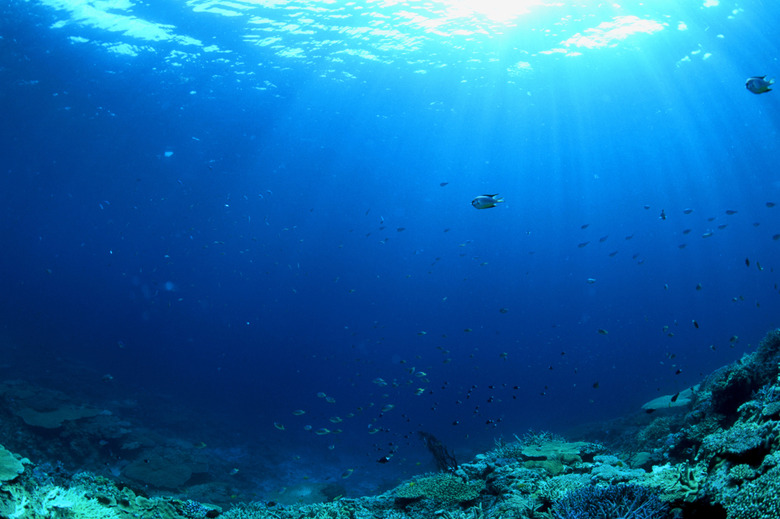Major Facts About The Open Ocean Ecosystem
The Earth's surface is 70 percent ocean. The open ocean is the area that doesn't come into contact with land.
The deepest part of the open ocean is thought to be nearly 7 miles (11 kilometers) deep. Over half of the ocean has a depth of least 1.86 miles (3 kilometers).
Ocean Ecosystem Facts
Ocean Ecosystem Facts
The open ocean produces more than 50 percent of the world's oxygen through photosynthetic algae. Ocean ecosystems can be broadly divided into two kinds: the open ocean or pelagic zone and the seafloor or benthic zone.
The pelagic zone is further divided into five ecological zones. The epipelagic, mesopelagic, bathypelagic, abyssopelagic and hadopelagic are defined based on their depth.
Epipelagic Zone
Epipelagic Zone
The epipelagic zone reaches from the surface to around 650 feet (200 meters). This zone is especially important as it is the region with the most light. Phytoplankton use this light to make energy through photosynthesis, a process that also converts carbon dioxide into oxygen.
The term plankton refers to plants, phytoplankton, animals, and zooplankton that have minimal control over their movement and are reliant on ocean currents to move them around. Nekton are animals that have control over where they swim like whales, dolphins, squid, larger fish and crustaceans.
Phytoplankton are the **primary producers** of the ocean and are at the base of the food web for both zooplankton and nekton.
Mesopelagic Zone
Mesopelagic Zone
The mesopelagic zone carries on from the epipelagic zone to around 3,300 feet (1 kilometer). The mesopelagic zone has the most vertebrates on Earth living there.
Because of the red light absorption in the upper waters, a lot of the animals in this zone are black or red for camouflage. Many of the vertebrates and invertebrates that live here migrate up to the epipelagic zone in the safety of the night to feed.
Bathypelagic Zone
Bathypelagic Zone
Next is the bathyal zone which stretches down to 13,000 feet (4 kilometers). This zone doesn't get any sunlight at all. As a result, some species are blind and solely rely on other senses for direction, finding prey, avoiding predators and finding mates. Some organisms have symbiotic relationships with bioluminescent bacteria to generate their own light sources.
The famous anglerfish (Lophiiformes) are an excellent example of deep sea fish using bioluminescence. The females have a bright lure dangling in front of their faces to capture their prey. The prey gets tricked into thinking the lure is food. Lantern fish (Myctophidae) have bioluminescent markers on their heads, stomachs and tails thought to help them attract mates in the dark waters.
Fish at this depth may look vicious, like something from the movie alien, but they are typically very small due to the pressure of the ocean. Anglerfish species range from 8 to 40 inches (20 to 101 centimeters) long. Deep-sea creatures also have very compressed lungs that are high in hemoglobin to help them diffuse gases in and out of their tissues.
Abyssopelagic Zone
Abyssopelagic Zone
The abyssopelagic zone reaches from the bathyal zone to the sea floor. Very little life is found in this zone, hence the name. At this depth, the temperatures range between 32 to 39.2 Fahrenheit (0 to 4 degrees Celcius) and the water chemistry is very uniform.
The few organisms that live this deep tend to be black or grey and have streamlined bodies to move through the deep oceans.
Hadopelagic Zone
Hadopelagic Zone
What on Earth could be deeper than the sea floor? Deep-sea trenches of the Hadopelagic zone, of course! The Mariana Trench, located in the western North Pacific Ocean, is the deepest known place on Earth.
Canadian filmmaker James Cameron holds the world title for the deepest solo descent to 35,756 feet (10.898 kilometers).
References
- University of Hawaii: Pelagic Ecology
- National Education: Ocean Life Zones
- Encyclopaedia Britannica: Abyssal Zone
- Encyclopaedia Britannica: Mariana Trench
- Oceana: Open Ocean
- Science ABC: Why Do Deep-Sea Fishes Not Get Crushed By Pressure on the Sea Floor?
- BBC: Blue Planet
- Encyclopaedia Britannica: Lantern Fish
Cite This Article
MLA
Jerrett, Adrianne. "Major Facts About The Open Ocean Ecosystem" sciencing.com, https://www.sciencing.com/major-open-ocean-ecosystem-5924/. 10 July 2019.
APA
Jerrett, Adrianne. (2019, July 10). Major Facts About The Open Ocean Ecosystem. sciencing.com. Retrieved from https://www.sciencing.com/major-open-ocean-ecosystem-5924/
Chicago
Jerrett, Adrianne. Major Facts About The Open Ocean Ecosystem last modified August 30, 2022. https://www.sciencing.com/major-open-ocean-ecosystem-5924/
